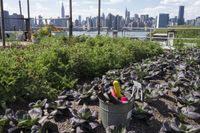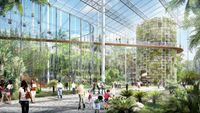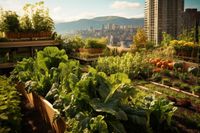Explore web search results related to this domain.

City-grown fruits and vegetables are more carbon-intensive than conventionally grown crops, but there are ways to address their emissions.
Rooftop farming in Brooklyn, New York.Photographer: Siegfried Layda/The Image Bank/Getty Images ... Fruits and vegetables grown in urban gardens in Europe and the US have a carbon footprint six times larger on average than the same produce grown on conventional farms, according to researchers.Farmers and gardeners at 73 urban agriculture sites in France, Germany, Poland, the UK and the US participated as citizen scientists in the research led by scientists at the University of Michigan and published on Monday in Nature Cities.

Our expert urban farmers will tend to your garden on a weekly basis to ensure full harvests and beautiful gardens. We select crops that will thrive in your location. · Plant, maintain, and harvest organic produce from your on-site garden. Green City Growers’ wellness garden programs enhance sustainability, improve health and wellness, attract and retain high quality candidates, and give back to the local community...
Our comprehensive garden and farm services can transform any space into a thriving urban farm that builds community.We design, build & maintain raised beds, in ground & rooftop farms, indoor growing systems, greenhouses; educational & wellness programming.We design gardens to be sustainable, beautiful, and successful year after year. In a collaborative process, we determine which set of options makes the most sense for each of our partners. · Raised beds provide a modular and versatile way of growing vegetables in an outdoor urban setting. There are various styles available to match a desired aesthetic. In-ground farms are great for large impact projects with good access to water and sun.Our mission is to provide urban farming solutions that encompass the entire growing season. From site construction to harvest Green City Growers is responsible for the success of the garden.
Tyfu Powys Final Gathering Thursday ... in, community gardening in Powys, come along to the… ... Are you a planner who would like to hear about the latest thinking on the application of TAN 6 rural enterprise dwelling policy to small scale horticultural farming ...
Tyfu Powys Final Gathering Thursday 23 January 2025 10:00 to 16:00 If you're involved in, or have an interest in, community gardening in Powys, come along to the… ... Are you a planner who would like to hear about the latest thinking on the application of TAN 6 rural enterprise dwelling policy to small scale horticultural farming enterprises?…Through projects and partnerships, we work with communities for people and the planet. We’d love you to join the movement too. Coventry University’s research aims to create a more sustainable UK food system through public sector food procurement · Coventry University’s research aims to create a more sustainable UK food system through ... Gardeniser Pro is the only course developed specifically to support and train the key, professional role of community garden manager or facilitator, with every aspect of your role…
Abstract Studies are showing that urban community gardening can improve people's psychological and physiological health in myriad ways. Community gardens increase social capital, provide opportunit...
Their social health was improved through gathering with other garden members in a sheltered urban green space within the city limits. This study supports the idea that participation in an urban community garden confers health benefits and engenders a greater awareness of, and appreciation for, the local environment and expands one's scope of care to incorporate planetary health.Abstract Studies are showing that urban community gardening can improve people's psychological and physiological health in myriad ways. Community gardens increase social capital, provide opportunit...Studies are showing that urban community gardening can improve people's psychological and physiological health in myriad ways. Community gardens increase social capital, provide opportunities for alt...I also like the idea that it supports a community of women in Rwanda that has little other help. I have sent many of my friends to the garden and they all love it as well. It has allowed me to try produce I have never eaten before. To enjoy the aesthetics and cultural values of the University Farm as a heritage landscape.

Some species require greater care in pest control and maintenance - such as pruning and frequent watering. Others, like some species , adapt easily to any environment. It is also necessary to take into account the size of the plant: the branch of a potato would spread through a whole balcony ...
However, generally with small size and other restrictions, the concerns of growing food in cities differ somewhat from traditional farming. Urban gardens can occupy a multitude of places and have varied scales - window sills and balconies, slabs and vacant lots, courtyards of schools, public parks and even unlikely places, such as subway tunnels. They can also be communitarian or private.NewsArticlesVegetationUrban FarmingMaterialsInterviewsCite: Souza, Eduardo. "Urban Farming: Food Production in Community Parks and Private Gardens" [Agricultura Urbana: Produção de alimentos em parques comunitários e jardins particulares] 17 May 2021. ArchDaily. Accessed .Urban agriculture is bound to grow and attract public and political eyes. Making food production closer is sustainable and pedagogical.Some species require greater care in pest control and maintenance - such as pruning and frequent watering. Others, like some species , adapt easily to any environment. It is also necessary to take into account the size of the plant: the branch of a potato would spread through a whole balcony if left unattended. Save this picture! ... Urban community agriculture often occurs on empty land - private or public - or in areas such as squares, parks, schools.

Through this program we also promote ... community and school gardening policies. Urban agriculture is defined as growing food and raising animals in cities, accompanied by complementary activities such as processing and distributing food, collecting and reusing food waste and rainwater, and educating, organizing, and employing local residents. Some examples of urban agriculture include hydroponics, urban apiary, aquaponics, backyard chickens for egg production, and rooftop farming...
Through this program we also promote urban agriculture, connect gardeners to resources in their communities, and help to identify supportive community and school gardening policies. Urban agriculture is defined as growing food and raising animals in cities, accompanied by complementary activities such as processing and distributing food, collecting and reusing food waste and rainwater, and educating, organizing, and employing local residents. Some examples of urban agriculture include hydroponics, urban apiary, aquaponics, backyard chickens for egg production, and rooftop farming.An urban apiary in Rochester, New York. Source: Sweet Beez. An aquaponics project in Buffalo, New York. Source: Massachusetts Avenue Project. City chickens in Brooklyn, New York. Source: Walt L. Shamel Community Garden - Just Food, credit to Buff Strickland. A rooftop farm in Brooklyn, New York.Source: Brooklyn Grange Rooftop Farm. In addition to beautifying city blocks and providing needed green space in areas where public parks are scarce, community gardeners grow nutritious fresh foods for families, communities, and emergency food sites. Gardens and urban farms are centers of learning where children discover the natural world and find out where food comes from.Urban Agriculture Resources - USDA Ground Rules: a Legal Toolkit for Community Gardens The Five Borough Farm Data Collection Toolkit Cornell's Healthy Soils, Healthy Communities Program Brownfields and Urban Agriculture Resources - US EPA Laws related to community gardens in New York State Stakeholder Outreach Call 1 - August 23, 2022 - Urban Farms and Community Garde…

PSRC’s mission is to ensure a thriving central Puget Sound, now and into the future, through planning for regional transportation, growth management and economic development.
Skill development in horticulture, urban agriculture, and sustainable farming practices can enhance employability. C. Environmental Sustainability · Urban farming and community gardens promote sustainability by reducing the carbon footprint associated with food transportation.
Small-scale agriculture and gardening activities can create micro-enterprises and strengthen local economies. Skill development in horticulture, urban agriculture, and sustainable farming practices can enhance employability. C. Environmental Sustainability · Urban farming and community gardens promote sustainability by reducing the carbon footprint associated with food transportation.Composting and waste reduction practices within community gardens support environmental sustainability. In conclusion, our proposal seeks to address the pressing issues of food security, economic opportunities, and community well-being in urban areas through the establishment of urban farming and community gardens.Urban farming and community gardens can provide meaningful employment and income generation opportunities for local residents.Urban farming and community gardens offer an opportunity for residents to cultivate a variety of fresh fruits and vegetables, leading to improved access to nutritious foods.


We highly recommend hiring professional ... carefully transplant them into the soil as soon as possible and care for them. In conclusion, the diverse community gardens and green spaces exemplify urban farming in Jersey City....
We highly recommend hiring professional movers specializing in fragile items to ensure they arrive safely at the new destination. Once they get there, carefully transplant them into the soil as soon as possible and care for them. In conclusion, the diverse community gardens and green spaces exemplify urban farming in Jersey City.We couldn’t do it without our sponsors: the Riverview Neighborhood Association, Farms in the Heights, The City of Jersey City, SK Landscaping and Design, A.B. Cruz General Construction and Palisade Wine and Liquors. 285 Ogden Avenue Riverview Community Garden is a 501c3 Non-Profit Organization that has been an integral part of the Jersey City Heights community since 1995. First, you need to become a member. Membership allows you to care for community areas (such as our food share, medicinal and pollinator plots), to have daily access to the garden, and to get involved with activities such as composting & beekeeping.Discover urban farming in Jersey City! Explore community gardens and green spaces for eco-conscious families.Jersey City, renowned for its lively urban landscape, also has a thriving community of urban farmers and gardeners. Amidst the concrete jungle, a network of community gardens and green spaces provides families with opportunities to cultivate their patches of greenery.
285 Ogden Avenue Riverview Community Garden is a 501c3 Non-Profit Organization that has been an integral part of the Jersey City Heights community since 1995. First, you need to become a member. Membership allows you to care for community areas (such as our food share, medicinal and pollinator ...
We highly recommend hiring professional movers specializing in fragile items to ensure they arrive safely at the new destination. Once they get there, carefully transplant them into the soil as soon as possible and care for them. In conclusion, the diverse community gardens and green spaces exemplify urban farming in Jersey City.We couldn’t do it without our sponsors: the Riverview Neighborhood Association, Farms in the Heights, The City of Jersey City, SK Landscaping and Design, A.B. Cruz General Construction and Palisade Wine and Liquors. 285 Ogden Avenue Riverview Community Garden is a 501c3 Non-Profit Organization that has been an integral part of the Jersey City Heights community since 1995. First, you need to become a member. Membership allows you to care for community areas (such as our food share, medicinal and pollinator plots), to have daily access to the garden, and to get involved with activities such as composting & beekeeping.Discover urban farming in Jersey City! Explore community gardens and green spaces for eco-conscious families.Jersey City, renowned for its lively urban landscape, also has a thriving community of urban farmers and gardeners. Amidst the concrete jungle, a network of community gardens and green spaces provides families with opportunities to cultivate their patches of greenery.


How a small home garden can preserve traditional food-growing practices.
The Cherokee Nation uses these gardens to teach citizens and visitors about plants with cultural significance to the nation. Photos courtesy of the Cherokee Nation · Mackey said older members of the Medicine Keepers tell stories about how clusters of plants like that used to be abundant around the reservation. The loss of plants “dovetails with climate change,” Mackey said. “The plants take care of us.In 2019, after returning from serving in the U.S. Navy as an aircraft engine mechanic, Brandon said he was compelled to start his family garden again. “I just thought, ‘Man, we need to invest in this land again,’” Brandon said. “That’s when we started growing.” · Climate change has threatened Indigenous communities’ access to traditional foods, such as fish, game, and wild and cultivated crops — resources that have provided sustenance and cultural, economic, medicinal, and community health for generations.Brandon said he’s encouraged others in his community to start their own home gardens and to keep traditional food-growing practices alive. His concerns about climate change extend beyond the reach of his own home.Brandon said he’s unsure whether his small garden can be a solution to such a large problem. Right now what he grows is enough to boost other meals for him and his family. There’s beans to add to chili, and corn and squash for side dishes. He has visions of a community approach — people growing, people cultivating and people that can cook.
Urban farms often receive formal institutional support, becoming integrated into local town planning as a “transition town” movement for sustainable urban development. A community garden is a single piece of land gardened collectively by a group of people.
When thinking about gardening and farming, images of inner city Detroit, South Central Los Angeles or the Bronx do not normally come to mind. On the contrary, you may envision rolling fields, red barns, and cow pastures. However, as urban agriculture and community gardens continue to grow, helping city-dwellers return to their roots in a whole new way, these stereotypes are beginning to change.What exactly are urban farms and community gardens? Are they different? If so, how? And more importantly, how can you support them?Urban farms often receive formal institutional support, becoming integrated into local town planning as a “transition town” movement for sustainable urban development. A community garden is a single piece of land gardened collectively by a group of people.Commercial urban farms are often aimed at expanding production on generally small land area with innovations in technologies such as aquaculture, hydroponics, and greenhouses — and may partner with a commercial kitchen to create locally-produced value-added products such as jams and sauces. Community gardens on the other hand are generally more socially-driven, focused on the benefits of having green spaces and the educational access that grows from them.


In conclusion, community gardens and urban farming are essential for enhancing urban residents' nutrition and livelihoods. These programmes offer a wide range of advantages for people, communities, and the environment, as we have discussed throughout this debate.
Activities like gardening and farming promote community, cooperation, and a sense of belonging. Environmental Benefits: Urban farming promotes sustainability by reducing food miles, minimizing the use of pesticides and synthetic fertilizers, and enhancing green spaces in cities.In conclusion, community gardens and urban farming are essential for enhancing urban residents’ nutrition and livelihoods.Nutrition Enhancement: Urban farming and community gardens provide access to fresh, locally grown produce, which is often lacking in urban food deserts.Economic Opportunities: By engaging in urban farming and community gardening, individuals and communities can generate income through the sale of surplus produce or value-added products.

So, whether you have a green thumb ... in urban farming or community gardening in the Bay Area. Not only will you be contributing to a healthier, more sustainable community, but you’ll also reap the numerous physical and mental health benefits that come with this rewarding activity. At Brown & Toland Physicians, we understand the importance of preventive care and holistic ...
So, whether you have a green thumb or just want to learn more about gardening, consider getting involved in urban farming or community gardening in the Bay Area. Not only will you be contributing to a healthier, more sustainable community, but you’ll also reap the numerous physical and mental health benefits that come with this rewarding activity. At Brown & Toland Physicians, we understand the importance of preventive care and holistic health.Urban farming and community gardening not only provides fresh, healthy produce but also offers a multitude of health benefits.Gardening has been shown to reduce the risk of obesity, heart disease, and diabetes, while also improving flexibility, strength, and endurance. In addition to the physical benefits, urban farming and community gardening can have a positive impact on mental health.Community gardens also foster a sense of connection and belonging. They provide a space for people to come together, share knowledge, and work towards a common goal. This social interaction can combat feelings of isolation and loneliness, which can have detrimental effects on both mental and physical health. Furthermore, urban farming and community gardening increase access to fresh, healthy produce.
The idea is based on creating a “green square” that is open to all to use, such as for educational activities, public talks and more. Read more in the Orto Wow factsheet. Orti Generali are the community urban gardens that are part of regenerating the derelict Cascina Piemonte area.
Abandoned parts of the Sangone Park were redesigned and used for community urban gardens. The aim was to improve the safety of the area and encourage community activities and productivity. In the Piemonte Park, 2.5 hectares of land were used for social farming activities including teaching, training and for job placements.Orto Wow - the courtyard of an abandoned building - has 15 garden boxes with aromatic plants and other melliferous plants that attract pollinating insects and hosts a weekly farmers market organized by the farmer association Coldiretti. The idea is based on creating a “green square” that is open to all to use, such as for educational activities, public talks and more. Read more in the Orto Wow factsheet. Orti Generali are the community urban gardens that are part of regenerating the derelict Cascina Piemonte area.Near the gardens, proGIreg partner - the local NGO 'Green and Blue Sesvete' (ZIPS) - has set up a proGIreg info centre as a meeting point for the local community, offering lectures, workshops, exhibitions and round tables. Learn more about the info point from this factsheet. ProGIreg implemented a therapeutic garden designed in collaboration with local associations working with people with disabilities, including spaces for activities, respite and urban farming for a wide variety of users.Post-industrial areas often lack green spaces for public use. Turning unused urban land into productive community gardens can have a positive impact on locals, contributing to improved mental and physical health through exposure to nature and healthy sources of food and a community feeling.
Overcoming these obstacles often ... urban farming initiatives. In conclusion, urban agriculture and community gardens offer numerous benefits to you and your community. By providing access to fresh, nutritious produce, these projects promote food security and improved health. They also create opportunities for education, skill-building, and community engagement. However, establishing and maintaining these initiatives can be challenging, requiring careful planning, ...
Overcoming these obstacles often requires engaging with local government officials and advocating for policy changes to support urban farming initiatives. In conclusion, urban agriculture and community gardens offer numerous benefits to you and your community. By providing access to fresh, nutritious produce, these projects promote food security and improved health. They also create opportunities for education, skill-building, and community engagement. However, establishing and maintaining these initiatives can be challenging, requiring careful planning, collaboration, and support from local authorities and organizations.Did you have knowledge that urban agriculture community gardens, with the help of volunteers, are transforming cities across the globe, bringing peace to the urban areas? With a staggering 800 million people involved in urban farming worldwide, the movement is gaining momentum and reshaping our urban landscapes.Community gardens provide valuable educational opportunities, allowing individuals to learn about gardening, nutrition, sustainability, and community building. Accessing land and water can be a challenge in urban areas. Explore partnerships with local governments, businesses, or organizations to secure suitable spaces for urban agriculture projects. Selling produce from urban farms and gardens not only provides economic opportunities but also strengthens local food systems and promotes healthier eating habits within the community.Urban agriculture and community gardens play a crucial role in improving access to fresh and nutritious food in urban areas. In many cities, especially low-income neighborhoods known as “food deserts,” there is a lack of grocery stores or farmers markets that offer affordable, healthy options.

Contents1 Vertical Gardens and Urban Farming: A Sustainable Solution for Urban Environments1.1 Introduction2 Historical Background3 Key Concepts and Definitions4 Main Discussion Points4.1 Benefits of Vertical Gardens and Urban Farming4.2 Design and Implementation of Vertical Gardens and Urban ...
Contents1 Vertical Gardens and Urban Farming: A Sustainable Solution for Urban Environments1.1 Introduction2 Historical Background3 Key Concepts and Definitions4 Main Discussion Points4.1 Benefits of Vertical Gardens and Urban Farming4.2 Design and Implementation of Vertical Gardens and Urban Farms4.3 Social and Community Impact of Vertical Gardens and Urban Farming5 Case Studies or Examples6 Current Trends orVertical Gardens and Urban Farming have a significant social and community impact. These practices enhance community engagement and education on sustainable agriculture, promoting awareness about the importance of local food production. They also create opportunities for job creation and entrepreneurship, empowering individuals to become self-sufficient.Vertical Gardens and Urban Farming face challenges such as limited access to space and high implementation costs. The requirement of specialized equipment and infrastructure can make these practices financially inaccessible for some communities. Additionally, there are concerns about potential environmental impacts, such as energy consumption for artificial lighting or water usage for irrigation.Vertical Gardens and Urban Farming offer a sustainable solution for addressing food security and sustainability challenges in urban environments. Through increased food production, improved air quality, efficient land use, and community engagement, these practices have the potential to create a more resilient and self-sufficient urban landscape.

What’s the first thing to come to mind when you hear the word “farm?” Most people will envision an open pasture or rolling hills lined with crops. However, urban community gardens make agriculture possible in metropolitan areas — and serve a significant purpose in nourishing the population.
Next, you’ll need to know the rules and zoning requirements for implementing urban agriculture where you live. For instance, the NYC Parks GreenThumb program supports over 550 urban community gardens and farms throughout the five boroughs.Hunger is a growing crisis in the U.S. as more households fall below the poverty line. Read how urban community gardens can help feed people.Other benefits of urban gardens include the following: ... Most commercial food products travel 1,500, losing 30% of their nutritional value. With urban community gardens, citizens can access freshly harvested goods with the highest quality nutrition possible at an affordable price.For instance, the American Heart Association awards annual grants to various community garden projects delivering access to food and nutritional education in underserved communities. Establishing an urban community garden in your city can make a significant difference in delivering food equity.
The gardens at Riverland Park and Kennedy Homes are examples of community gardens. Urban farms can grow the same sort of produce, but they may specialize in one or a few varieties or delve into raising animals or beekeeping at the discretion of private owners.
Urban farms may be singly owned or owned cooperatively, and they are zoned differently from community gardens. Produce is usually raised for the purpose of direct sale to the surrounding community or distribution to local restaurants and markets. Because they are businesses, investments in innovative or experimental equipment, such as hydroponic tanks, is common.Most urban farms are very engaged in their communities, offering educational opportunities, hosting charitable events, and employing local residents. Fort Lauderdale's Marando Farms is a fine example of an urban farm. Participants in community gardens and owners of urban farms both tend to be proponents of sustainable agriculture.We are compiling a directory of local gardens, farms and markets. Please check our listing in process on our Local Farms, Gardens and Markets webpage. If you do not see your favorite spot, click on the Feedback link above and submit the following information. Name of Community Garden, Urban Farm or Farmers MarketOur Sustainability Coordinator will contact the owners or administrators of the garden, farm or market to verify information and obtain permission to list it on our website. Once that process has been completed, it will be added to our Urban Agriculture map. Are you interested in starting a community garden?

Here's how to reduce the climate impact of urban farming | CBC News Loaded ... A study published earlier his year in the science journal Nature suggests gardeners should evaluate the carbon footprint of things like co-operative or collective gardens by looking at what they use to build them and, as importantly, what they grow and how they grow it. Stephanie Cram · CBC News · Posted: Apr 18, 2024 7:00 AM EDT | Last Updated: April 18 · Clint Porritt, director of Star Community ...
Here's how to reduce the climate impact of urban farming | CBC News Loaded ... A study published earlier his year in the science journal Nature suggests gardeners should evaluate the carbon footprint of things like co-operative or collective gardens by looking at what they use to build them and, as importantly, what they grow and how they grow it. Stephanie Cram · CBC News · Posted: Apr 18, 2024 7:00 AM EDT | Last Updated: April 18 · Clint Porritt, director of Star Community Garden in St.The study employed citizen science at 73 urban agriculture sites (think co-operative or collective gardens, not necessarily your backyard garden) across Europe and the United States. It compared food from large-scale conventional agricultural farms and urban agriculture sites, including professionally managed urban farms, individual gardens and collective gardens.Your garden’s carbon footprint isn’t as small as you may think ... Duration 3:27A study published in Nature found that the carbon footprint of food grown via urban agriculture is six times greater than conventional agriculture, and for one main reason. CBC’s Stephanie Cram explains why, and shares one farmer’s tips for keeping your carbon emissions down.While some studies have previously looked at high-tech gardens such as vertical farms, researchers looked at low-tech urban farms.







